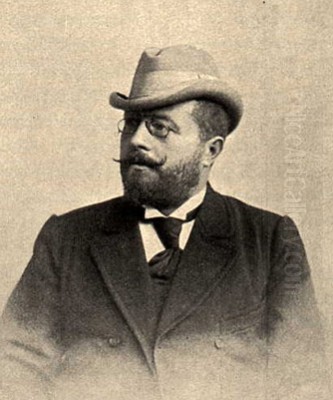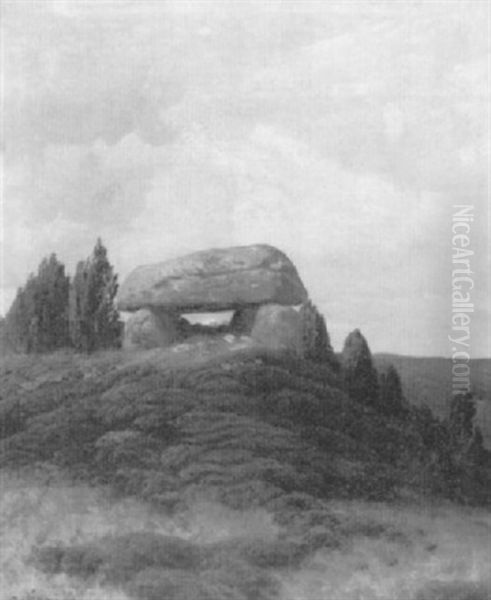
Rudolf Hellgrewe (1860-1935) stands as a notable, if at times complex, figure in German art history. Primarily recognized as a landscape painter, his body of work offers a fascinating window into the artistic currents of his time, particularly the European fascination with distant lands and the burgeoning, often problematic, visual culture of colonialism. His canvases captured not only the familiar scenery of his native Germany, especially the Mark Brandenburg region, but also the then-exotic and imposing landscapes of East Africa, securing him a distinct place among artists documenting the German colonial enterprise.
Early Life and Artistic Formation
Born in Hammerstein, Silesia (now Czarne, Poland), in 1860, Rudolf Hellgrewe's artistic inclinations led him to Berlin, which was rapidly becoming a major cultural and artistic hub in Europe. He pursued his formal artistic education at the prestigious Royal Academy of Arts in Berlin (Königlich Preußische Akademie der Künste). This institution was a cornerstone of artistic training in Germany, shaping generations of painters, sculptors, and architects.
During his time at the Academy, Hellgrewe studied under the tutelage of influential figures such as Eugen Bracht (1842-1921) and Christian Wilberg (1839-1882). Bracht, himself a renowned landscape painter, was known for his atmospheric depictions and later developed a keen interest in Orientalist themes, undertaking journeys to Egypt, Palestine, and Syria. His influence likely instilled in Hellgrewe a sensitivity to the nuances of light and atmosphere, as well as potentially sparking an interest in landscapes beyond Europe. Christian Wilberg, though his life was cut short, was celebrated for his architectural paintings and landscapes, often imbued with a romantic sensibility. The guidance of these mentors would have provided Hellgrewe with a solid foundation in academic painting techniques, particularly in the genre of landscape.
The Allure of Africa: Expeditions and Colonial Imagery
A pivotal moment in Hellgrewe's career was his expedition to East Africa in 1895-1896. This journey was undertaken during the height of European colonial expansion, a period when German East Africa (comprising parts of present-day Tanzania, Burundi, and Rwanda) was a significant colonial territory. Such expeditions were often fraught with challenges but offered artists unparalleled opportunities to depict landscapes and cultures largely unseen by European audiences.

Hellgrewe's experiences in East Africa profoundly shaped his artistic output and public reputation. He became one of the most recognized painters associated with German colonial subjects and African travel literature. His works from this period often depicted the vast, dramatic scenery of the region – primeval forests, sweeping savannas, and majestic mountains, most notably Mount Kilimanjaro. These images were disseminated through publications, including his own illustrated book Aus Deutsch-Ostafrika: Meine Reiseerlebnisse und Beobachtungen (From German East Africa: My Travel Experiences and Observations), further cementing his role as a visual chronicler of the German colonial presence.
His depictions of Africa were characterized by a keen eye for detail and what was considered a "modern" style at the time, likely referring to a departure from purely romanticized or overly idealized portrayals towards a more direct, observational approach, though still filtered through a European lens. These works were instrumental in shaping the German public's visual understanding of its African colonies.
Artistic Style, Themes, and Techniques
Rudolf Hellgrewe's primary focus was landscape painting. His oeuvre can be broadly divided into depictions of his native German landscapes, particularly the tranquil lakes and forests of the Mark Brandenburg region surrounding Berlin, and his more famous works stemming from his African travels. He worked predominantly in oils, a medium that allowed for rich color and detailed rendering. However, he also produced works in other media, including pastels, such as his notable depictions of Mount Kilimanjaro, and charcoal and pencil drawings, particularly for studies of religious architecture and figures.
His style is often described as exhibiting fine detail and a strong sense of atmosphere. In his German landscapes, one might observe a quiet naturalism, capturing the specific character of the local environment. His African scenes, while also detailed, often convey a sense of grandeur and the sublime, emphasizing the scale and untamed nature of the continent as perceived by European explorers. Titles such as Heidelandschaft (Heath Landscape) and Küstenlandschaft mit Schiff und Treibern (Coastal Landscape with Ship and Drovers) suggest a range of subjects, from serene inland scenes to dynamic coastal views.
The "modernity" attributed to his style likely refers to his engagement with a more direct, less overtly sentimentalized form of landscape painting, perhaps influenced by Realist or early Impressionist tendencies that valued observation, though he remained largely within a representational, academic tradition. His works were typically signed, and as is common with art of this period, pieces appearing on the market today may show signs of age, such as minor craquelure or wear.
Hellgrewe in the Context of Colonial Art
Understanding Hellgrewe's work, particularly his African subjects, requires acknowledging the colonial context in which it was created and received. He held a significant position within Berlin's colonial institutions, suggesting an alignment with, or at least a participation in, the prevailing colonialist and nationalist ideologies of the German Empire. His art, in this sense, can be seen as part of a broader cultural project that served to familiarize the German populace with its overseas territories and, implicitly or explicitly, to legitimize colonial rule.
Art historians today critically examine colonial art, noting that it often presented a Eurocentric view. Hellgrewe's depictions of East Africa, for instance, have been critiqued for portraying the land as "empty," "uninhabited," or "culturally and politically undeveloped." Such portrayals could inadvertently or intentionally reinforce the colonial narrative of Africa as a terra nullius awaiting European "civilization" and development, thereby overlooking or minimizing the presence and agency of indigenous populations. His travels, it's noted, often followed established routes and utilized the infrastructure of colonial entities like the German East Africa Company, rather than venturing into entirely unknown territories in the manner of some earlier explorers.
Despite these critical perspectives, Hellgrewe's work remains historically significant. His paintings and illustrations are valuable visual documents that reflect European perceptions and artistic representations of Africa during the colonial era. They offer insights into the intersection of art, exploration, and empire, providing a tangible link to a complex and often troubling period of history.
Contemporaries and the Wider Artistic Milieu
Rudolf Hellgrewe operated within a vibrant and evolving German art scene. His training under Eugen Bracht connected him to a lineage of landscape painting that was adapting to new influences. Bracht himself, after an early phase influenced by the romanticism of the Düsseldorf School, later embraced more impressionistic techniques and, as mentioned, Orientalist themes, reflecting a broader European artistic engagement with non-Western cultures.
In Berlin, Hellgrewe would have been aware of various artistic movements. The Berlin Secession, founded in 1898 by artists like Max Liebermann (1847-1935), Lovis Corinth (1858-1925), and Walter Leistikow (1865-1908), challenged the conservative dominance of the official Academy salon, championing German Impressionism and other modern styles. While Hellgrewe's style might not have aligned directly with the avant-garde Secessionists, their presence signified a dynamic artistic environment. Leistikow, in particular, was known for his melancholic landscapes of the Brandenburg region, offering a different artistic interpretation of the same local scenery Hellgrewe sometimes painted.
The tradition of German landscape painting was rich and varied. Earlier figures like Caspar David Friedrich (1774-1840) had established a powerful Romantic tradition, while the Düsseldorf School, with artists such as Andreas Achenbach (1815-1910) and Oswald Achenbach (1827-1905), excelled in dramatic and meticulously detailed landscapes, often incorporating international scenes. Hans Thoma (1839-1924) represented another strand, with his idyllic and somewhat symbolist depictions of German landscapes.
The interest in "exotic" or colonial subjects was not unique to Hellgrewe or Germany. In France, Eugène Delacroix (1798-1863) had famously depicted North African scenes decades earlier, and Jean-Léon Gérôme (1824-1904) was a leading figure of Orientalism. Within Germany itself, artists like Gustav Bauernfeind (1848-1904) also gained fame for their detailed paintings of the Middle East. Hellgrewe's focus on East Africa placed him within this broader European trend of artists venturing beyond the continent to capture new subjects, though his work was specifically tied to Germany's own colonial ambitions. The director of the Berlin Academy during part of Hellgrewe's active years, Anton von Werner (1843-1915), was a dominant figure in historical painting, often depicting scenes of Prussian glory, reflecting the nationalist fervor of the era which also underpinned colonial expansion. Even earlier landscape painters like Carl Blechen (1798-1840) had shown a penchant for dramatic light and Italian scenes, prefiguring the German artistic interest in foreign climes.
While direct evidence of specific collaborations or intense rivalries with these contemporaries is scarce in the provided information, Hellgrewe undoubtedly operated within this complex web of artistic influences, institutional structures, and evolving tastes. His choice to specialize in colonial landscapes gave him a particular niche.
Legacy, Auction Performance, and Art Historical Assessment
Rudolf Hellgrewe's legacy is multifaceted. He is remembered as one of the foremost German painters of colonial landscapes, and his works serve as important historical documents, offering visual testimony to the German colonial presence in Africa and the European artistic response to these encounters. His book, Aus Ost-Afrika, remains a significant piece of travel literature from the period.
In the contemporary art market, Hellgrewe's works appear at auction with some regularity. Prices for his paintings can vary significantly based on size, subject matter, condition, and provenance. Generally, his oil paintings command prices ranging from a few hundred to several thousand Euros. For instance, smaller seascapes or mountain landscapes might be estimated in the €80 to €180 range, while larger or more significant works, such as a substantial mountain landscape (e.g., 70x100 cm), could be estimated between €500 and €700. More detailed or sought-after subjects, like coastal scenes or cityscapes, might fall in the €200 to €400 bracket. Exceptional pieces have been known to reach up to €4000. These figures reflect a steady interest among collectors of historical German art and colonial-era paintings.
Art historians evaluate Hellgrewe as a skilled landscape painter whose work is inextricably linked to the colonial project. While his artistic technique and ability to capture the atmosphere of diverse landscapes are acknowledged, modern scholarship also critically engages with the ideological underpinnings of his colonial imagery. His depictions of Africa, while visually striking, are often seen through the lens of postcolonial theory, which scrutinizes the power dynamics inherent in colonial representations.
His contribution, therefore, is viewed with nuance. He provided a visual record that shaped perceptions and contributed to a genre of colonial art, yet this genre itself is now understood within a framework that acknowledges its role in the broader mechanisms of empire. His paintings of the Mark Brandenburg, on the other hand, situate him within the long tradition of German landscape art, appreciated for their local character and observational skill.
Conclusion: An Artist of His Time
Rudolf Hellgrewe was, in many ways, an artist of his time. His career spanned a period of intense nationalism, colonial expansion, and significant artistic change in Germany. He successfully navigated these currents, establishing a reputation as a specialist in both domestic and colonial landscapes. His education at the Berlin Academy under notable teachers like Eugen Bracht and Christian Wilberg provided him with the technical skills, while his adventurous spirit led him to East Africa, resulting in the works for which he is perhaps best known.
Today, his paintings are valued not only for their aesthetic qualities but also as historical artifacts that provoke reflection on the complex relationship between art, representation, and power. While the colonial gaze embedded in some of his most famous works invites critical scrutiny, Rudolf Hellgrewe's oeuvre remains a significant contribution to the visual culture of late 19th and early 20th-century Germany, offering enduring images of landscapes both near and far, and prompting ongoing discussion about the role of the artist in society.